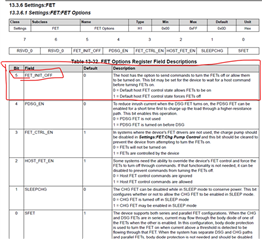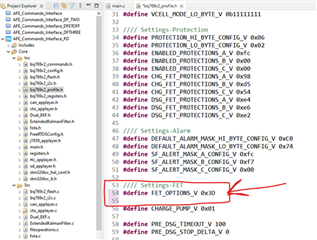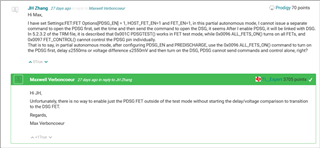Dear Engineering team at TI, here is the problem description.
We are trying to use the AFE (BQ7695202) in partial autonomous FET control mode to control the PRE-DISCHARGE (PDSG) MOSFET. As per the requirement, we are supposed to start the BMS with all the FETs disabled. Next, we check for the stack and load side voltages and control the turn ON of the PDSG based on the difference between the stack and load voltages (Delta). If the delta is greater than 2 Volts, we turn ON the PDSG for 2 seconds, turn it OFF after these 2 seconds are elapsed and again check for the delta. If the delta is lesser than 2 Volts, we can now proceed to turn ON the main discharge MOSFETS (DSG). In case the delta is still greater than 2 Volts, we wait for 1 minute before the PDSG is turned ON for 2 seconds and then repeat this cycle. The main DSG MOSFETs are not allowed to turn ON until and unless the delta is lower than 2 Volts. In implementing this logic, I have followed the instructions from the technical reference manual (TRM) and data sheet (DS) where it suggests that “FET_INIT_OFF” bit field must be set for host (MCU) controlled FET turn-ON as shown in Fig 1.

Fig 1. FET Control register (from page 168 of TRM)
Following these instructions, the FET options has been set to 0011 1101 (which translates to 0x3D in hexadecimal). The bit mappings are shown in Table 1.
Table 1. Bit field configuration for PDSG control used in the current firmware
|
Bit Number |
7 |
6 |
5 |
4 |
3 |
2 |
1 |
0 |
|
Bit Field |
RSVD_0 |
RSVD_1 |
FET_INIT_OFF |
PDSG_EN |
FET_CTRL_EN |
HOST_FET_EN |
SLEEPCHG |
SFET |
|
Binary Value |
0 |
0 |
1 |
1 |
1 |
1 |
0 |
1 |
|
Hex Value |
3 |
D |
||||||
The same settings have been applied in the firmware as well and this is shown in Fig 2.

Fig 2. Applied settings for the FET control from the firmware shows 0x3D
The logical implementation in embedded C language has been shown.
|
/* *************************************************************************************************************************************************************************************** */ /* ************** * MANUAL CONTROL OF PRE-DISCHARGE MOSFET WITH LD PIN VOLATAGE AND CUSTOM TIMEOUT * ************** */ /* *************************************************************************************************************************************************************************************** */ if (INIT_MODE==1) { //Main IF INIT_MODE=0; for (int pd_ind=0; pd_ind<5; pd_ind++) { //PD Count FOR
//Collect the data from the AFE status = BMS_CollectData(&msg);
if (status != HAL_OK) { // AFE Status IF APP_DEBUG("I2C Connection Lost\r\n");
gBMSFault.bit.AFE = 0x01; HAL_GPIO_WritePin(GPIOA, LED1_Pin, GPIO_PIN_SET);
} else { gBMSFault.bit.AFE = 0x00; HAL_GPIO_WritePin(GPIOA, LED1_Pin, GPIO_PIN_RESET);
ThisBMS.Stack_Voltage =*(uint16_t *) &msg. BatVoltsAndCurrent_t.batVoltsAndCurrent[0]; ThisBMS.LD_Voltage =*(uint16_t *) &msg.BatVoltsAndCurrent_t.batVoltsAndCurrent[2];
if (ThisBMS.Stack_Voltage - ThisBMS.LD_Voltage > 200 ) { // LD Check IF //Turn ON PDSG-MOS for 1 second if(BQ769x2_PDSG_Enable() != AFE_OK) { while(1); }
HAL_Delay(1000); //Wait for 1 second
//Turn OFF PDSG-MOS after 1 second if(BQ769x2_PDSG_Disable() != AFE_OK) { while(1); }
} else { //Turn ON MAIN-MOS if(BQ769x2_DSG_Enable() != AFE_OK) { while(1); }
//Break out of the loop break; } //end LD Check IF
//Wait for 1 minute for (int del_ind=0; del_ind<4; del_ind++) { HAL_Delay(1000); }
} //end AFE Status IF
if (pd_ind==4) { //Disable the PDSG-MOS if(BQ769x2_PDSG_Disable() != AFE_OK) { while(1); } //Disable the MAIN-MOS if(BQ769x2_DSG_Disable() != AFE_OK) { while(1); } } } // end PD Count FOR
} //end MAIN IF
|
However, the PDSG MOSFET is not turning ON as intended as we were not able to detect any gate pulse being sent from the AFE. The code has been de-bugged several times and the MCU is executing all these lines successfully.
The E2E forums hosted by TI mentions that the PDSG mosfets cannot be individually controlled as shown in Fig 3. This is where we require assistance.

Fig 3. TI E2E forums discussing the pre-discharge capabilities.
We sincerely request your help and support in this regard.

